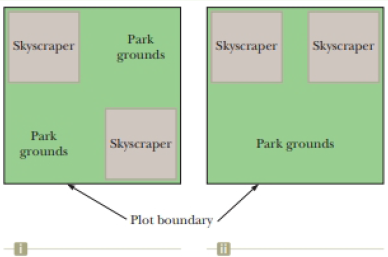
Concept explainers
You are working as an expert witness for the owner of a skyscraper complex in a downtown area. The owner is being sued by pedestrians on the streets below his buildings who were injured by falling glass when windows popped outward from the sides of the building. The Bernoulli effect can have important consequences for window’s in such buildings. For example, wind can blow around a skyscraper at remarkably high speed, creating low pressure on the outside surface of the windows. The higher atmospheric pressure in the still air inside the buildings can cause windows to pop out. (a) In your research into the case, you find some overhead views of your client’s project, as shown below. The project includes two tall skyscrapers and some park area on a square plot. Plan (i) (Fig. P14.26(i), page 382) was submitted by the original architects and planners. At the last minute, the owner decided he didn’t want the park grounds to be divided into two areas and submitted Plan (ii) (Fig. P14.26(ii), which is the way the project was built. Explain to your client why Plan (ii) is a much more dangerous situation in terms of windows popping out than Plan (i). (b) Your client is not convinced by your conceptual argument in part (a), so you provide a numerical argument. Suppose a horizontal wind blows with a speed of 11.2 m/s outside a large pane of plate glass with dimensions 4.00 m × 1.50 m. Assume the density of the air to be constant at 1.20 kg/ m3. The air inside the building is at atmospheric pressure. Calculate the total force exerted by air on the windowpane for your client. (c) What If? To further convince your client of the problems with the building design, calculate the total force exerted by air on the windowpane if the wind speed between the buildings is 22.4 m/s, twice as high as in part (b).
Figure P14.26

Want to see the full answer?
Check out a sample textbook solution
Chapter 14 Solutions
PHYSICS:F/SCI.+ENGRS.(LL)-W/WEBASSIGN
Additional Science Textbook Solutions
College Physics: A Strategic Approach (3rd Edition)
General, Organic, and Biological Chemistry - 4th edition
Microbiology Fundamentals: A Clinical Approach
- As a box is lifted against gravity and placed on a shelf, how does the work done by the lifter compare with the work done by gravity? What is the net work done on the box? What does this imply about its change in kinetic energy? Use definitions and mathematics from this chapter to answer these questions.arrow_forwardAs I carry a box up a flight of stairs, am I doing positive work or negative work on the box? Provide a mathematical explanation.arrow_forwardAs a ball falls under the influence of gravity, does gravity do positive work or negative work? Provide a mathematical explanation.arrow_forward
- Under what circumstances is it bad to describe kinetic energy as k = 1/2mv^2arrow_forwardNo chatgpt pls will upvotearrow_forwardAir temperature of 37 °C increases swimming pool temperature of 2.55 °C. What is the fraction of the water in the pool must evaporate during this time to carry enough energy to keep the temperature of the pool constant? 4186 J/(kg°C) = specific heat of water 2,430,000 (2.43 x 106) J/kg = latent heat of vaporization for the water in the pool.arrow_forward
- The iceberg requires 7.4 x 1020 Joules of energy to melt it completely. It absorbs energy from the Sun at a constant average rate of 88 Watts/m2. The total surface area of iceberg exposed to the sunlight is 12 billion (1.2 x 1010) square meters. How long will it take for sunlight to melt the entire iceberg in yearsarrow_forward1.0 kg block of ice to melt in the kitchen. The temperature in the kitchen is 31 °C. The ice starts out at 0 °C and takes an hour to melt and reach the same temperature as the surrounding room (31 °C). How much heat does the 1.0 kg of ice/water absorb from the room as it melts and heats up to 31 °C in Joules absorbed? Latent heat of fusion for water/ice is 334,000 J/kg Specific heat of water is 4186 J/kg°Carrow_forward5.84 If the coefficient of static friction between a table and a uni- form, massive rope is μ, what fraction of the rope can hang over the edge of the table without the rope sliding? 5.97 Block A, with weight Figure P5.97 3w, slides down an inclined plane S of slope angle 36.9° at a constant speed while plank B, with weight w, rests on top of A. The plank is attached by a cord to the wall (Fig. P5.97). (a) Draw a diagram of all the forces acting on block A. (b) If the coefficient of kinetic friction is the same between A and B and between S and A, determine its value. 36.9° 1arrow_forward
 Principles of Physics: A Calculus-Based TextPhysicsISBN:9781133104261Author:Raymond A. Serway, John W. JewettPublisher:Cengage Learning
Principles of Physics: A Calculus-Based TextPhysicsISBN:9781133104261Author:Raymond A. Serway, John W. JewettPublisher:Cengage Learning Physics for Scientists and Engineers: Foundations...PhysicsISBN:9781133939146Author:Katz, Debora M.Publisher:Cengage Learning
Physics for Scientists and Engineers: Foundations...PhysicsISBN:9781133939146Author:Katz, Debora M.Publisher:Cengage Learning Physics for Scientists and EngineersPhysicsISBN:9781337553278Author:Raymond A. Serway, John W. JewettPublisher:Cengage Learning
Physics for Scientists and EngineersPhysicsISBN:9781337553278Author:Raymond A. Serway, John W. JewettPublisher:Cengage Learning Physics for Scientists and Engineers with Modern ...PhysicsISBN:9781337553292Author:Raymond A. Serway, John W. JewettPublisher:Cengage Learning
Physics for Scientists and Engineers with Modern ...PhysicsISBN:9781337553292Author:Raymond A. Serway, John W. JewettPublisher:Cengage Learning College PhysicsPhysicsISBN:9781938168000Author:Paul Peter Urone, Roger HinrichsPublisher:OpenStax College
College PhysicsPhysicsISBN:9781938168000Author:Paul Peter Urone, Roger HinrichsPublisher:OpenStax College College PhysicsPhysicsISBN:9781305952300Author:Raymond A. Serway, Chris VuillePublisher:Cengage Learning
College PhysicsPhysicsISBN:9781305952300Author:Raymond A. Serway, Chris VuillePublisher:Cengage Learning





